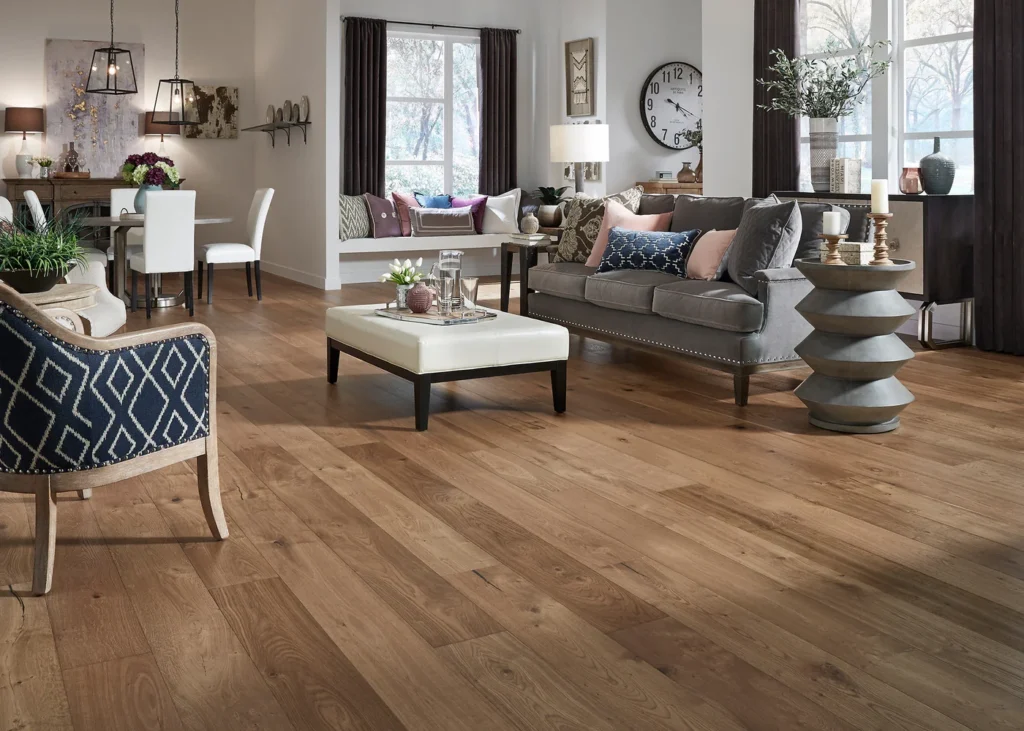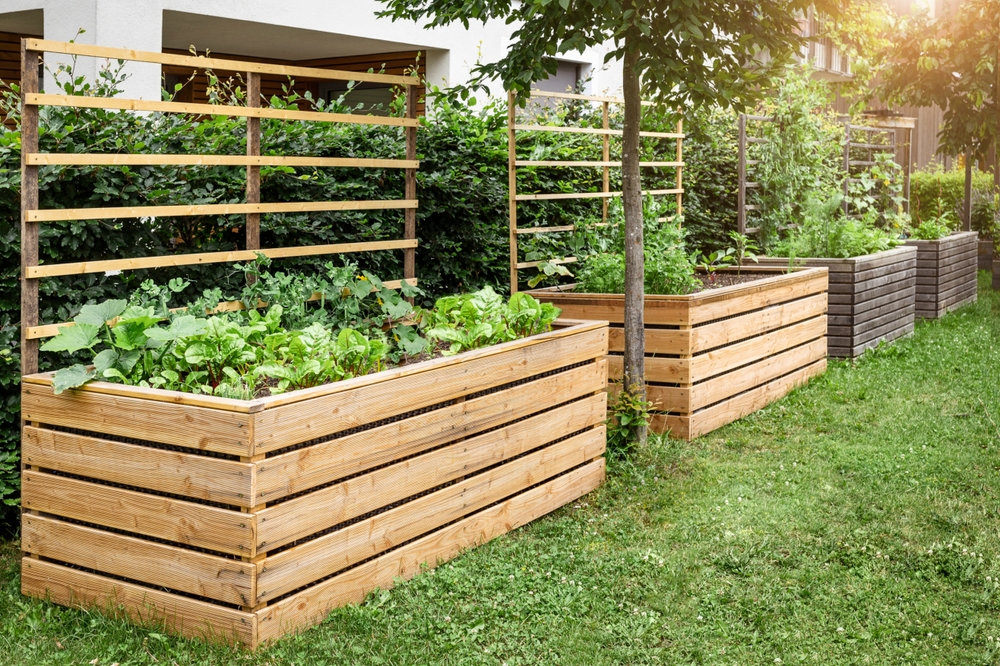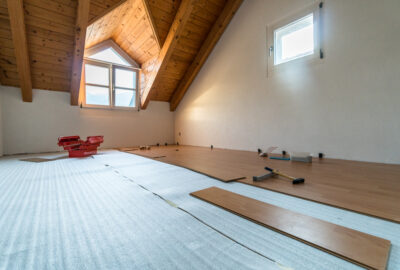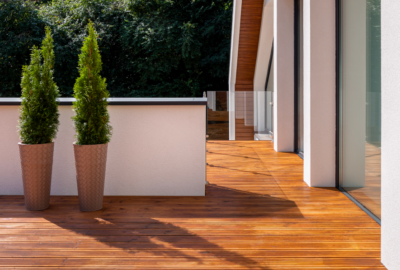Flooring, Hardwood
Engineered Hardwood vs. Solid Hardwood Flooring: Which Is Best for Your Home?
Hardwood flooring is one of the most timeless, elegant, and value-boosting choices for any home. But if you’re planning to install new wood floors, there’s one major decision to make: engineered hardwood or solid hardwood?
At first glance, they may look nearly identical, but their structure, performance, and ideal applications differ. This guide breaks down everything homeowners, designers, and contractors need to know before deciding between engineered hardwood vs solid hardwood flooring.
What Is Solid Hardwood Flooring?
Solid hardwood flooring is made from a single piece of natural wood. Each plank is typically ¾ inch thick and milled from species like oak, maple, walnut, or cherry.
Because the entire plank is solid wood, it can be sanded and refinished multiple times throughout its life. Solid wood floors are known for their long-term durability and authentic appearance, making them a popular choice for traditional and upscale homes.

What Is Engineered Hardwood Flooring?
Engineered hardwood flooring is made of a top layer of real hardwood bonded to several layers of plywood or high-density fiberboard. This layered construction adds stability, making engineered wood less prone to warping or shifting due to moisture or temperature changes.
Although it contains less solid wood overall, engineered hardwood still provides the look and feel of real wood and comes in a variety of finishes, species, and styles.

Appearance: Do They Look the Same?
Both solid and engineered hardwood feature a top layer of real wood, so visually, they can appear almost identical. You’ll find similar:
- Wood species (oak, hickory, maple, etc.)
- Colors and stains
- Plank widths and lengths
- Finishes (matte, satin, gloss)
- Textures (hand-scraped, wire-brushed, smooth)
Solid wood tends to develop a natural patina over time, enhancing its character. Engineered wood, especially when prefinished, maintains a more uniform appearance for longer periods.
Durability and Longevity: How Long Do They Last?
Solid hardwood floors can last 50 to 100 years with proper care. Because they can be sanded and refinished multiple times, they’re ideal for long-term use in high-traffic areas.
Engineered hardwood floors typically last between 20 and 40 years, depending on the thickness of the wear layer. Higher-quality engineered planks (with a 3mm–6mm wear layer) can be refinished once or twice, extending their lifespan.
Key factors affecting durability:
- Wood species (e.g., oak is harder than pine)
- Finish type (aluminum oxide finishes offer stronger protection)
- Thickness of the plank and wear layer
Moisture Resistance: Which Handles Humidity Better?
Engineered hardwood is more resistant to moisture and humidity than solid hardwood. Its multi-layered structure reduces expansion and contraction, making it suitable for:
- Basements
- Kitchens
- Areas with radiant heating
- Homes in humid climates
Solid hardwood is more sensitive to moisture and can warp or swell if exposed to high humidity or water. It’s best suited for:
- Above-grade rooms
- Spaces with consistent indoor climate control
Neither option is ideal for full bathrooms or other areas with standing water, where tile or vinyl might be better choices.
Installation Methods: Which Is Easier to Install?
Solid hardwood must be nailed or stapled to a wooden subfloor. Installation is more complex and generally requires professional help. It’s not recommended for concrete subfloors or below-grade levels.
Engineered hardwood can be installed using multiple methods:
- Nail-down
- Glue-down
- Floating (click-lock systems)
Because of this flexibility, engineered flooring is easier to install over concrete, radiant heat systems, and in basements. It’s also more DIY-friendly.
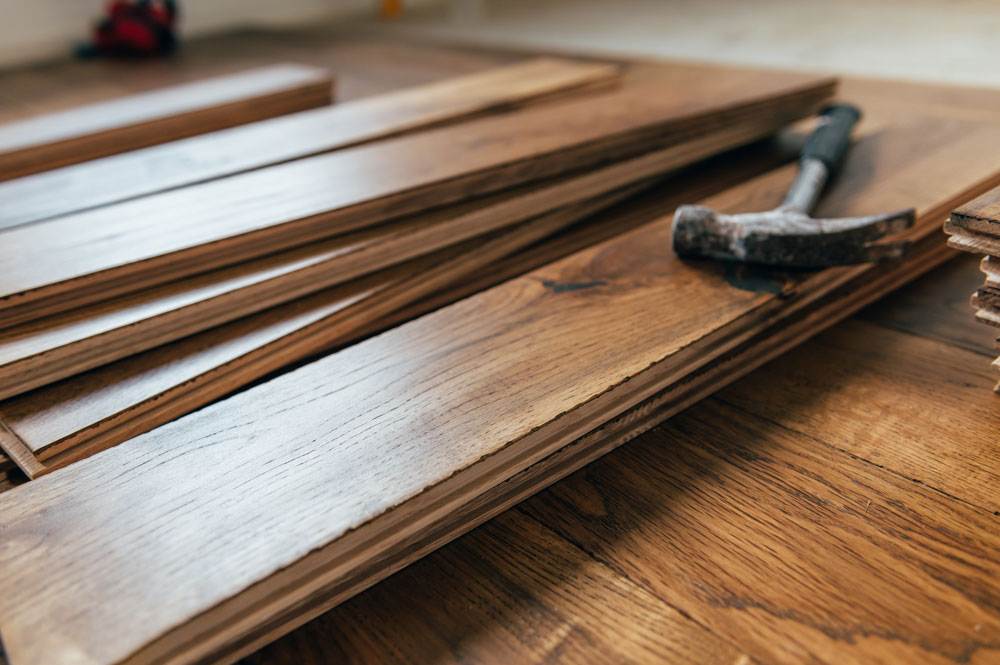
Maintenance and Cleaning: What Should You Expect?
Both types of flooring require similar maintenance care:
- Sweep or vacuum regularly to remove dirt and grit
- Wipe up spills immediately to avoid staining or warping
- Use a damp mop and hardwood-specific cleaner (never soak the floor)
Solid hardwood can handle deeper cleaning and periodic refinishing. Engineered hardwood with a thinner veneer may not tolerate aggressive sanding, but high-quality engineered floors still allow for minor repairs and refinishing.
Refinishing: Can You Sand and Refinish Both?
Solid hardwood can be sanded and refinished multiple times, up to 5–7 times over its lifetime, depending on wear. This makes it ideal for homes with heavy foot traffic or pets.
Engineered hardwood can only be refinished if the wear layer is thick enough (usually 2mm–4mm minimum). Some entry-level engineered products cannot be sanded at all, limiting their long-term renewability.
If refinishing is a priority, solid hardwood offers greater flexibility over time.
Cost Comparison: Which Is More Affordable?
Pricing varies based on wood species, plank size, finish, and brand. Here’s a general breakdown:
Solid Hardwood Flooring Cost
- Material cost: $8 – $15 per sq. ft.
- Installation cost: $4 – $8 per sq. ft.
- Total installed cost: $12 – $23 per sq. ft.
Engineered Hardwood Flooring Cost
- Material cost: $4 – $10 per sq. ft.
- Installation cost: $2 – $6 per sq. ft.
- Total installed cost: $6 – $16 per sq. ft.
Engineered hardwood typically costs less, especially when factoring in labor. It’s also more cost-effective for large areas or homes with concrete subfloors.
Environmental Impact: Which Is More Eco-Friendly?
Engineered hardwood tends to use less slow-growing hardwood overall, making it a more resource-efficient option in many cases. Its core layers are often made from fast-growing trees, reducing environmental impact.
Solid hardwood, although longer lasting, consumes more hardwood per square foot. However, when responsibly sourced and maintained, it can be a sustainable long-term choice.
Look for certifications like:
- (Forest Stewardship Council)
- CARB Phase 2 compliance for low VOCs
- FloorScore® for indoor air quality
Both flooring types can be eco-friendly if purchased from reputable manufacturers.
Where Should Each Type Be Installed?
Ideal places for solid hardwood:
- Living rooms
- Dining rooms
- Bedrooms
- Hallways
- Above-grade levels
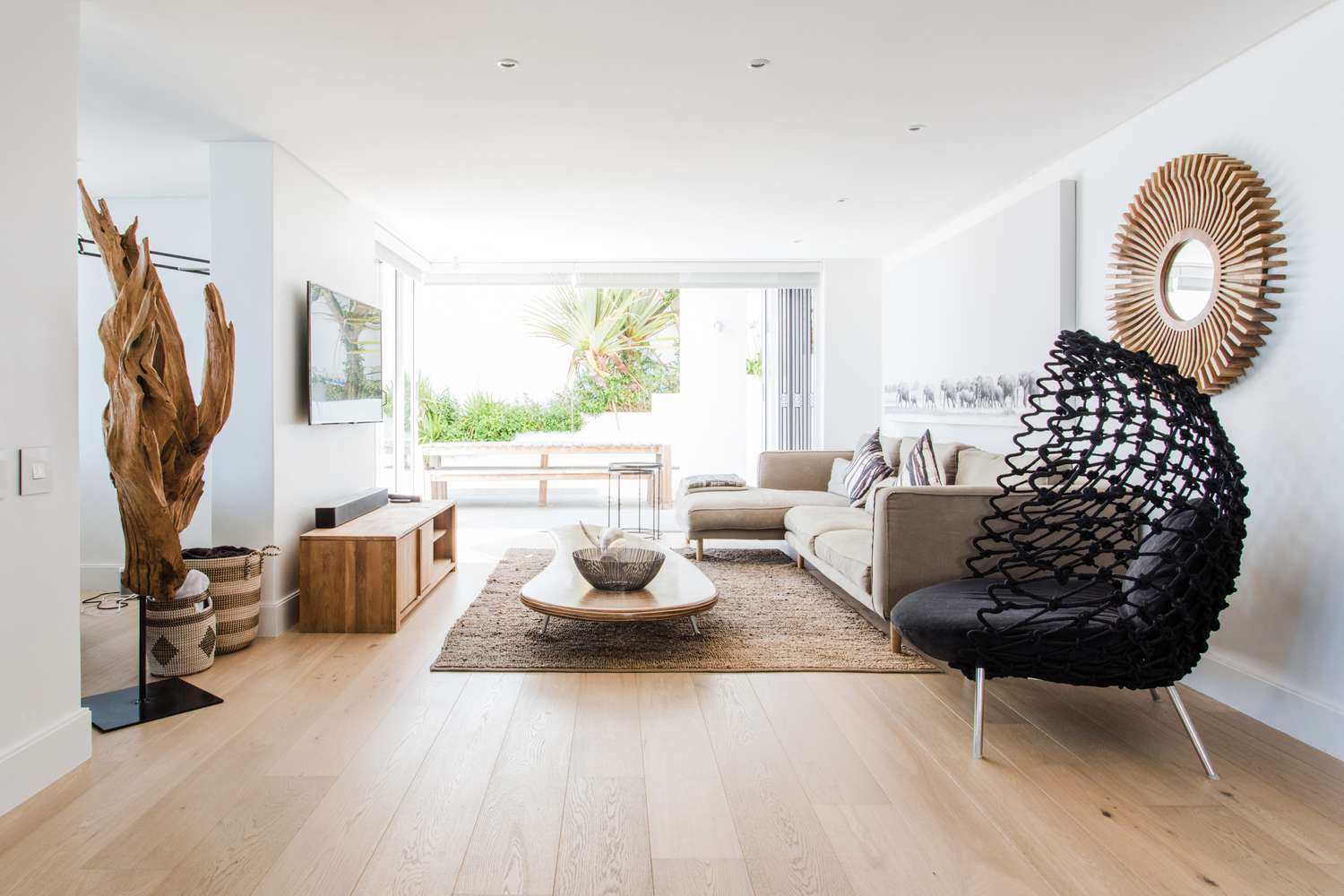
Ideal places for engineered hardwood:
- Basements
- Kitchens
- Over radiant heating systems
- Concrete subfloors
- High-humidity environments
Engineered hardwood offers greater flexibility across different areas of the home. However, solid hardwood remains a preferred choice for classic applications in traditional homes.
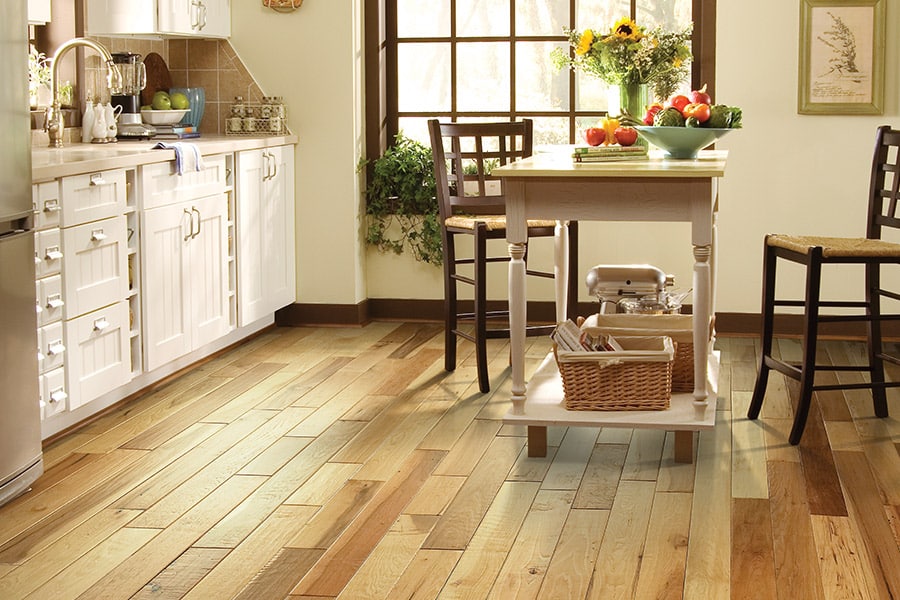
Sound and Feel Underfoot: Are There Differences?
Solid hardwood offers a dense, firm, and authentic feel underfoot. Many homeowners prefer the sound and tactile sensation of walking on solid wood.
Engineered hardwood may feel slightly different, especially if installed as a floating floor. Some varieties can feel less solid due to the underlayment or thinner core. That said, many high-end engineered products are nearly indistinguishable in feel.
Adding proper underlayment can improve acoustic performance and comfort for engineered flooring.
Resale Value: Does One Add More Home Value?
Both solid and engineered hardwood add value to a home. Buyers appreciate real wood floors for their appearance, durability, and easy maintenance.
Solid hardwood might have an edge in terms of resale value due to its longer lifespan and refinishing capability. However, high-quality engineered hardwood is also considered a premium flooring option and is increasingly accepted in the real estate market.
When maintained properly, either flooring type enhances curb appeal and can influence homebuyers’ decisions.
Common Myths About Engineered and Solid Hardwood
Myth 1: Engineered hardwood is fake wood.
False. Engineered wood has a real hardwood top layer.
Myth 2: You can’t refinish engineered wood.
False. Many engineered floors can be refinished depending on the veneer thickness.
Myth 3: Solid wood is always better.
Not necessarily. It depends on your home’s subfloor, humidity, and budget.
Key Considerations Before Choosing
When deciding between engineered and solid hardwood, consider the following:
- Budget: Engineered wood is typically more affordable
- Climate: Engineered handles humidity better
- Location: Basements and concrete require engineered
- Longevity: Solid hardwood lasts longer with refinishing
- DIY Installation: Engineered is easier for non-professionals
- Style & Species Preference: Both offer similar aesthetic options
So, Engineered Hardwood vs Solid Hardwood Flooring: Which Is Better?
Both engineered and solid hardwood flooring offer the beauty and benefits of natural wood. While solid hardwood is known for its longevity and traditional appeal, engineered hardwood provides flexibility and moisture resistance that suit modern living conditions.
The best choice depends on your specific needs, space, subfloor type, and lifestyle. Understanding how each flooring type performs in different conditions ensures you make a well-informed decision that adds comfort, style, and value to your home for years to come.
FAQs
Can engineered hardwood and solid hardwood be used together in the same house?
Yes, many homeowners mix both types strategically. Engineered hardwood may be used in moisture-prone or below-grade areas like basements, while solid hardwood is reserved for living rooms and bedrooms. Just ensure similar species, finishes, and plank widths are used for a consistent look.
Is engineered hardwood considered “real” wood compared to solid hardwood?
Yes. Engineered hardwood has a top layer made of real hardwood, giving it the same visual appearance as solid wood. The main difference lies in its core construction, which is made of plywood or fiberboard layers for added stability.
How many times can you refinish engineered hardwood vs. solid hardwood?
Solid hardwood can be refinished multiple times, usually 5 to 7 times over its lifespan. Engineered hardwood can typically be refinished 1 to 3 times, depending on the thickness of the top veneer layer. Some lower-end engineered products cannot be refinished at all.
Which flooring type is better for radiant heat systems?
Engineered hardwood is better suited for radiant heating because its layered construction handles temperature fluctuations more effectively. Solid hardwood may expand or contract too much when exposed to radiant heat, leading to warping or gapping.
Does solid hardwood last longer than engineered hardwood?
Solid hardwood generally lasts longer, often 50 to 100 years, because it can be refinished many times. Engineered hardwood has a typical lifespan of 20 to 40 years, depending on the thickness of the top layer and how well it is maintained.
Which is better for homes with kids or heavy foot traffic?
Solid hardwood is more durable in the long run due to its thickness and refinishability. However, engineered hardwood with a tough factory-applied finish can also hold up well to scratches and wear, especially if the top layer is thick and the finish is high-quality.
Does engineered hardwood increase home value as much as solid hardwood?
Both can increase home value, but solid hardwood may be perceived as more premium due to its longevity and traditional status. High-quality engineered hardwood is also well-regarded in the market and often adds significant resale appeal.
Are there acoustic differences between engineered and solid hardwood?
Yes. Solid hardwood tends to feel and sound denser underfoot, with a more resonant “thud.” Engineered hardwood, especially when floated, may sound slightly more hollow unless paired with high-quality underlayment. Glue-down installation improves sound performance for engineered options.
Which flooring type is easier to install?
Engineered hardwood is easier to install, especially over concrete or in basements. It can be floated, glued, or nailed. Solid hardwood must be nailed or stapled to a wood subfloor, often requiring more labor and professional installation.
Is solid hardwood more sensitive to climate changes than engineered hardwood?
Yes. Solid hardwood is more prone to expansion and contraction with changes in humidity and temperature. Engineered hardwood’s cross-layered construction gives it greater dimensional stability, making it better suited to areas with climate fluctuations.
Comments are closed



